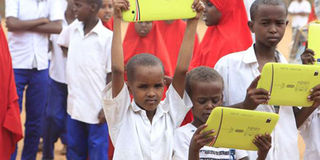More girls than boys enrolling in schools: Report

Pupils at Mandera DEB Primary School receive tablets on May 12, 2016. The latest Uwezo Report released on May 26, 2016 shows that there is a shift in attitude to opportunities to keep girls in school.
PHOTO | MANASE OTSIALO | NATION MEDIA GROUP
What you need to know:
The latest Uwezo Report also said that there is a shift in attitude to opportunities to keep girls in school.
Generally, children in arid areas have less access to education and progress through school at a much slower pace than those in other regions.
The findings, which were released on Thursday, show that while the country has made progress in its commitment to education, inequality was rife.
Industrialist Manu Chandaria, who presided over the launch of the report at Kenya Institute of Curriculum Development, rooted for access to quality education for all children.
Girls enrol more and progress through school faster than boys, a report says.
This is true in all parts of the country, except in the northeastern region.
The latest Uwezo Report also said that there is a shift in attitude to opportunities to keep girls in school.
It also reveals that 91 per cent of pupils under seven years enrolled in Standard One can identify letters, according to a report on the state of education in Kenya.
However, the latest Uwezo Report also reveals that 16 per cent of the children in that category in western Kenya are eight times less likely to identify letters as those in Nairobi.
The data was collected from more than 600,000 children in all counties.
It found out that 18 per cent of children in the same region cannot recognise numbers.
About two and three per cent in Nairobi cannot recognise letters and numbers, respectively.
The report considered, among other things, early childhood education and school readiness, access to and progression through primary school, adult school attendance and inequalities.
But while primary school enrolment is high, at 90 per cent, more than a third of pupils are not progressing through their classes at the right space.
In the Coast, four out of 10 children are behind their expected classes while the northeastern region was the poorest in terms of enrolment with 20 per cent not going to school.
Even after studies have shown that children who have had a nursery school education have better developmental outcomes in life, nearly half (43 per cent) of children in Standard One in East Africa did not attend pre-unit.
Generally, children in arid areas have less access to education and progress through school at a much slower pace than those in other regions.
The findings, which were released on Thursday, show that while the country has made progress in its commitment to education, inequality was rife.
The report also shows that 34 per cent of children in Kenya are born to teenage mothers with Nyanza (41 per cent) having the highest such cases.
QUALITY EDUCATION
Industrialist Manu Chandaria, who presided over the launch of the report at Kenya Institute of Curriculum Development, rooted for access to quality education for all children.
“As parents and teachers, we must take the issue of education seriously if we hope to develop this country,” said Dr Chandaria.
Kenya National Union of Teachers Secretary-General Wilson Sossion asked the government to put more resources in employment of teachers to achieve quality education.






